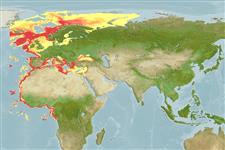Common names from other countries
Environment: milieu / climate zone / depth range / distribution range
Οικολογία
βενθοπελαγικό; εύρος βάθους 20 - 4595 m (Ref. 81305). Tropical, preferred 20°C (Ref. 107945); 85°N - 6°S, 26°W - 158°E (Ref. 112293)
Northeast Atlantic, Mediterranean and the Arctic: Congo Dem Rep to Gibraltar, Mediterranean, Spain to Iceland, to Russian Arctic up to Sakha Republic.
Length at first maturity / Μέγεθος / Βάρος / Age
Maturity: Lm 23.2, range 20 - ? cm Max length : 75.0 cm ML αρσενικό/απροσδιόριστο; (Ref. 3722); μεγ. δημοσιευμένο βάρος: 2.2 kg (Ref. 120431); μεγ. αναφερόμενη ηλικία: 2.00 έτη (Ref. 120431)
Common mantle length ranges between 25 and 35 cm (Ref. 3722). In the Mediterranean Sea no individual was caught in the hauls taken above a depth of 100 m (Ref. 81305). However, studies carried out in Norwegian waters indicated that it occurs in coastal and bank areas 80-200 m and even more superficially at 20-100 m (Ref.81307). It was also observed from the North Atlantic Ridge at a depth of 1947 m (Ref. 81308). Maximum depth from Ref. 1985.
Members of the class Cephalopoda are gonochoric. Male and female adults usually die shortly after spawning and brooding, respectively. Mating behavior: Males perform various displays to attract potential females for copulation. During copulation, male grasp the female and inserts the hectocotylus into the female's mantle cavity where fertilization usually occurs. Life cycle: Embryos hatch into planktonic stage and live for some time before they grow larger and take up a benthic existence as adults.
Schneider, W. 1990. (Ref. 417)
IUCN Red List Status (Ref. 130435: Version 2024-1)
CITES status (Ref. 108899)
Not Evaluated
Not Evaluated
Human uses
αλιεία: Εμπορικό(ά)
FAO - αλιεία: landings | FIRMS (Stock assessments) | FishSource | Η θάλασσα γύρω μας
Εργαλεία
Διαδικτυακές πηγές
Estimates based on models
Preferred temperature
(Ref.
115969): 2 - 14.3, mean 9.3 (based on 570 cells).
Prior r = 0.38, 95% CL = 0.25 - 0.57, Based on 2 data-limited stock assessments.
Vulnerability
Low to moderate vulnerability (30 of 100).
